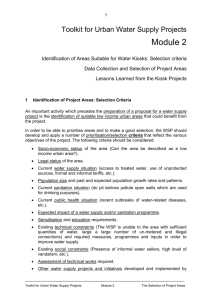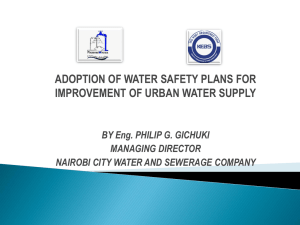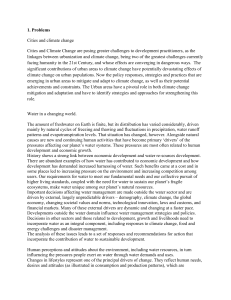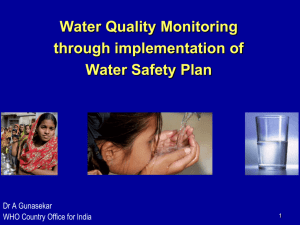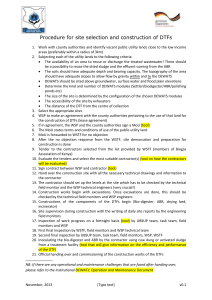Making Large-Scale Wind and Solar Power a Reality CGD Brief October 2013
advertisement
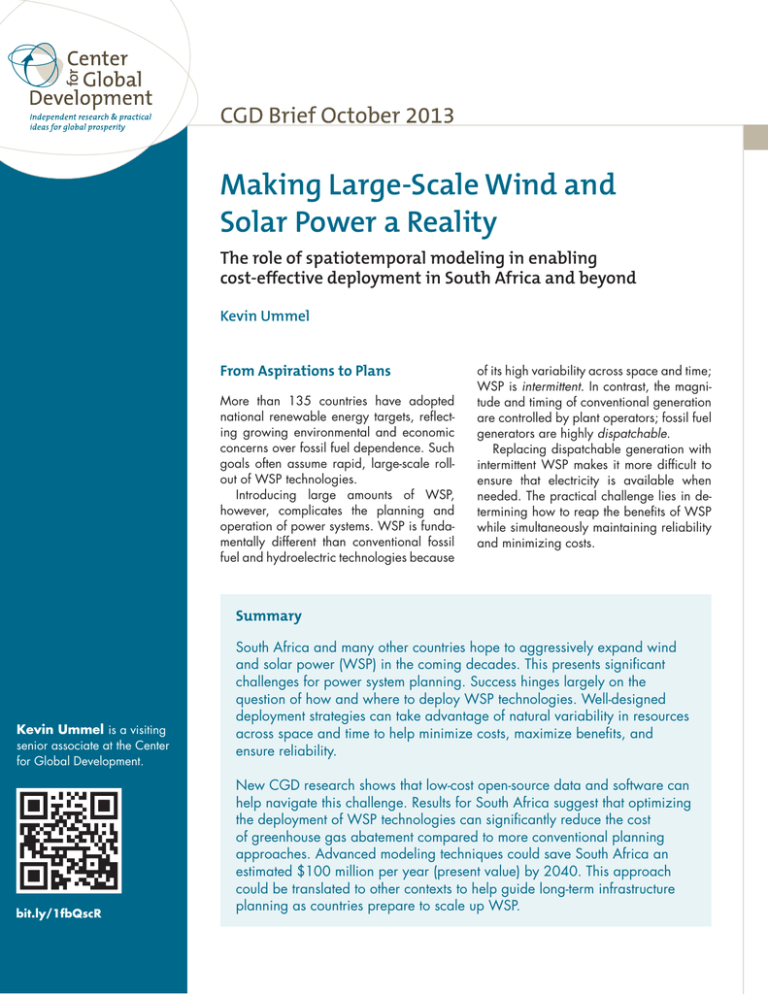
CGD Brief October 2013 Making Large-Scale Wind and Solar Power a Reality The role of spatiotemporal modeling in enabling cost-effective deployment in South Africa and beyond Kevin Ummel From Aspirations to Plans More than 135 countries have adopted national renewable energy targets, reflecting growing environmental and economic concerns over fossil fuel dependence. Such goals often assume rapid, large-scale rollout of WSP technologies. Introducing large amounts of WSP, however, complicates the planning and operation of power systems. WSP is fundamentally different than conventional fossil fuel and hydroelectric technologies because of its high variability across space and time; WSP is intermittent. In contrast, the magnitude and timing of conventional generation are controlled by plant operators; fossil fuel generators are highly dispatchable. Replacing dispatchable generation with intermittent WSP makes it more difficult to ensure that electricity is available when needed. The practical challenge lies in determining how to reap the benefits of WSP while simultaneously maintaining reliability and minimizing costs. Summary Kevin Ummel is a visiting senior associate at the Center for Global Development. bit.ly/1fbQscR South Africa and many other countries hope to aggressively expand wind and solar power (WSP) in the coming decades. This presents significant challenges for power system planning. Success hinges largely on the question of how and where to deploy WSP technologies. Well-designed deployment strategies can take advantage of natural variability in resources across space and time to help minimize costs, maximize benefits, and ensure reliability. New CGD research shows that low-cost open-source data and software can help navigate this challenge. Results for South Africa suggest that optimizing the deployment of WSP technologies can significantly reduce the cost of greenhouse gas abatement compared to more conventional planning approaches. Advanced modeling techniques could save South Africa an estimated $100 million per year (present value) by 2040. This approach could be translated to other contexts to help guide long-term infrastructure planning as countries prepare to scale up WSP. Making large-scale wind and solar power a reality Planning for Intermittency Because power systems are large and complex, critical to economic growth and security, and built of long-lived concrete and steel, their development requires comprehensive planning that spans multiple decades. While energy ministries and power companies have plenty of experience planning conventional power systems, very few have practical experience planning deployment for large-scale WSP systems, whose reliability and cost is highly spatially dependent. Once a WSP project is constructed, stochastic weather processes determine performance. Conventional planning models either ignore or greatly simplify this spatiotemporal complexity. In theory, system planners can reduce the cost of WSP integration through spatial and technological diversification, demand-side management, high-voltage transmission, real-time monitoring and forecasting, and other means. Determining the optimal combination of strategies is referred to as integrated generation management (O’Connor et al. 2010) or, more broadly, energy systems integration (Kroposki et al. 2012). The key planning question is how and where to deploy WSP infrastructure. Our skill in answering this question—which will require the use of evolving data sources and analytical tools—will largely determine the cost of transitioning to a cleaner, renewables-based future. Modeling Complexity in South Africa A recent CGD working paper I authored (Ummel 2013) shows how such issues can be addressed in the case of South Africa. The government’s stated objective is for WSP to provide more than 20 percent of generating capacity by 2030. A scenario developed by the state-owned utility Eskom envisions WSP penetration potentially reaching 40 percent by 2040. These are ambitious figures in a country that depends on coal for more than 90 percent of its electricity. Relying on open-source satellite data and software, I developed a 10-year hourly database of onshore wind, solar photovoltaic (PV), and concentrating solar power (CSP) generating efficiency for potential sites across South Africa. I then developed a simple power system model to simulate the economic and environmental performance of different WSP spatial deployment scenarios in the year 2040. The model adjusts the amount of backup gas generating capacity in the system to ensure a minimum level of reliability over 10 years of hourly simulation. A genetic search algorithm identifies WSP deployment patterns across space that minimize the cost of abating carbon dioxide (CO2) emissions. I use the 2040 Eskom scenario as a “default” example of a conventional approach to WSP planning. Figure 1 shows the implied WSP deployment pattern in 2040. Simulation of this default deployment strategy results in an abatement cost of $26.50 per tCO2 (2010 dollars). When the WSP deployment pattern is then spatially optimized (figure 2), the cost of CO2 abatement drops to $22.80 per tCO2—a decline of 14 percent. A model optimizing both the location and relative quantity of competing WSP technologies results in an abatement cost of just $15.70 per tCO2—a 40 percent decrease. The modeling also addresses the temporal integration of conventional generating technologies and WSP. Figure 3 shows how the various generating technologies in South Africa’s power system in 2040 integrate hour-by-hour, given the WSP deployment pattern in figure 2. These results are illustrative rather than prescriptive, but they suggest that advanced modeling techniques could save South Africa approximately $100 million by 2040 (present value), compared to more conventional planning approaches. Future Work and Applications Additional work is needed to incorporate transmission costs and constraints; simulate system expansion over time; and account for uncertainty in critical cost assumptions. None of these advances poses overwhelming technical challenges, but successful modeling efforts will require buy-in by stakeholders across the power sector. The general approach is transferable to other contexts. For larger countries, cost-effective exploitation CGD Brief October 2013 Figure 1: WSP deployment pattern in 2040 implied by default planning scenario Figure 2: WSP deployment pattern in 2040 that minimizes the cost of CO2 abatement Notice how PV and CSP facilities are concentrated in the northwest and wind farms more spatially dispersed, compared to the pattern in figure 1. Source: Ummel 2013. of domestic WSP resources remains the central task. Smaller countries (and larger countries within multinational power grids) may find excellent opportunities to collectively harness regional WSP resources, reaping economic and environmental benefits while strengthening ties with neighbors. An integrated deployment and transmission plan to exploit WSP resources across southern Africa, for example, could dramatically alter the economics of renewable energy in the region. Detailed knowledge of the spatiotemporal properties of renewable resources over large areas would be Source: Ummel 2013. required. In general, the returns to spatiotemporal modeling increase with the size of the region under study. This study suggests that high-resolution spatiotemporal data and modeling can identify WSP deployment strategies that offer significant savings. This approach does not require large research teams and budgets. With support from in-country stakeholders, low-cost data and techniques can Figure 3: Typical diurnal generation profile in 2040, given the WSP deployment pattern in figure 2. The plots summarize 10 years of hourly simulation results. Notice the reliance on natural gas power generation (OCGT and CCGT) during winter evenings to maintain reliability during the peak load period. Source: Ummel 2013. Kevin Ummel is a visiting senior associate at the Center for Global Development. How to Ensure Reliability and Minimize Costs of Wind and Solar Power Unlike conventional power technologies, wind and solar power (WSP) is not always available when needed. This reduces reliability, increases costs, and complicates planning for large-scale deployment of WSP. However, open-source data and modeling can help guide the deployment of WSP technologies to ensure reliability and minimize costs by taking advantage of natural spatiotemporal variability. Countries or regions seeking to develop long-term, spatially explicit WSP deployment strategies should take the following steps: 1) Determine wind and solar resource levels and identify geographic areas suitable for potential project or transmission siting. The latter should consider technological, economic, environmental, and sociopolitical constraints through consultation with stakeholders. 2)Create technology, fuel cost, and electricity demand projections in consultation with industry. Develop high-resolution hourly data describing the performance of WSP technologies in suitable locales. 3) Given available WSP resources and projected costs, determine what long-term deployment targets are politically feasible. Identify the primary political or economic constraints. 4)Using information from Steps 1–3, use spatiotemporal modeling to identify the optimal exploitation of WSP resources to meet the long-term targets. 5)Iterate Steps 3 and 4 in consultation with government, industry, and civil society organizations. Spatiotemporal modeling will reveal new information regarding costs, emissions, and infrastructure siting, which may alter stakeholder objectives and constraints. 6) Ensure that WSP and transmission procurement policies are aligned with the longterm deployment strategy. 7)Conduct periodic reviews as new information becomes available. The goal is adaptive deployment strategies that are robust to uncertainty. capture the most critical spatiotemporal dynamics and help countries intelligently harness their WSP resources to address climate change, air pollution, and energy security in a cost-effective and reliable manner. Works cited 1800 Massachusetts Ave NW Third Floor Washington DC 20036 202-416-4000 www.cgdev.org This work is made available under the terms of the Creative Commons Attribution-NonCommercial 3.0 license. Kroposki, B., B. Garrett, S. Macmillan, B. Rice, C. Komomua, M. O’Malley, and D. Zimmerle. 2012. Energy Systems Integration: A Convergence of Ideas. TP-6A00-55649. Golden, CO: National Renewable Energy Laboratory. http:// www.nrel.gov/esi/pdfs/55649.pdf. O’Connor, R., G. Reed, Z.-H. Mao, and A. K. Jones. 2010. “Improving Renewable Resource Utilization through Integrated Generation Management.” In Power and Energy Society General Meeting, 2010 IEEE. http://ieeexplore.ieee. org/xpl/articleDetails.jsp?arnumber=5589530. Ummel, K. 2013. “Planning for Large-Scale Wind and Solar Power in South Africa: Identifying CostEffective Deployment Strategies Using Spatiotemporal Modeling.” Center for Global Development Working Paper No. 340. Washington, DC: Center for Global Development. http://www.cgdev. org/publication/planning-large-scale-wind-andsolar-power-south-africa-identifying-cost-effective. The Center for Global Development is grateful to its board of directors and funders, including the Royal Danish Embassy, for support of this work.


